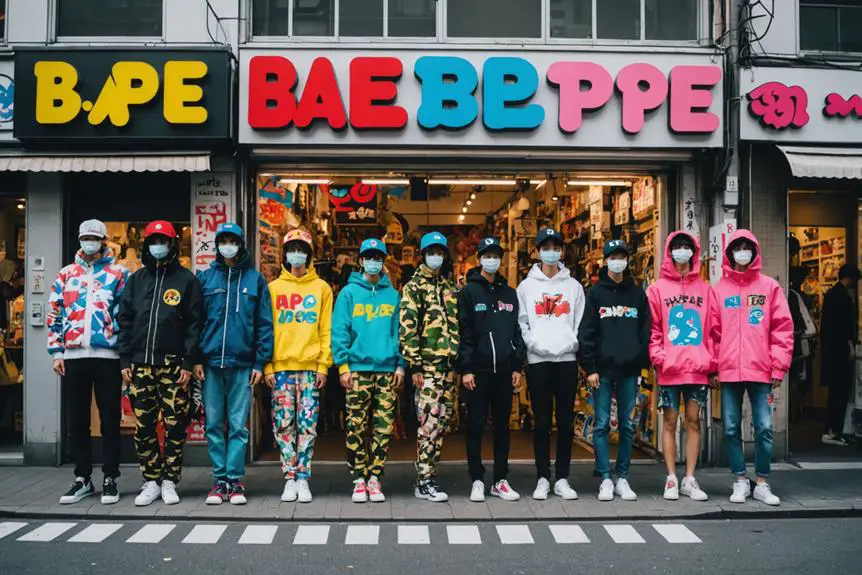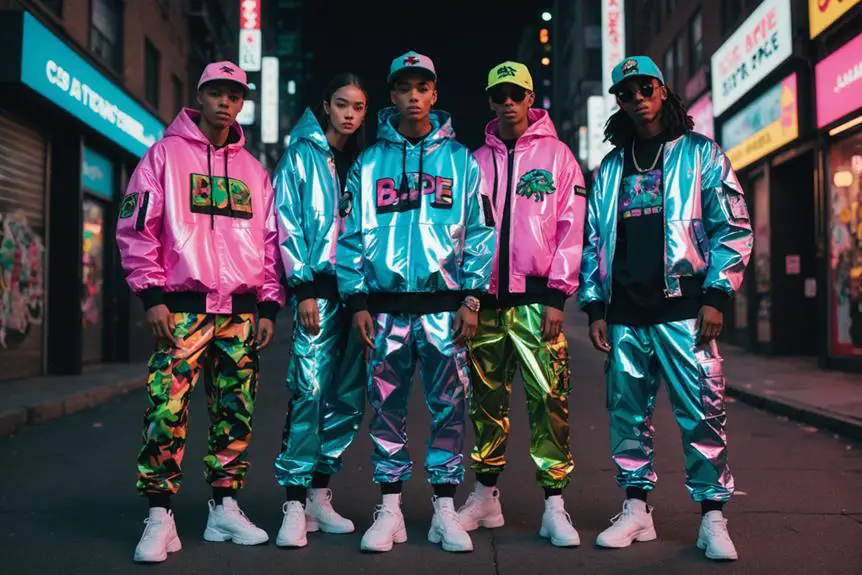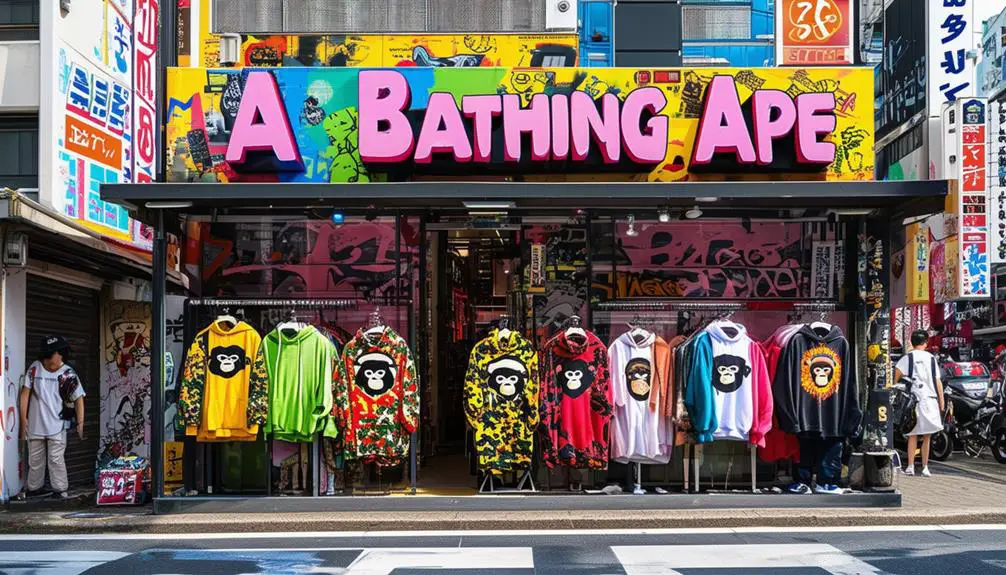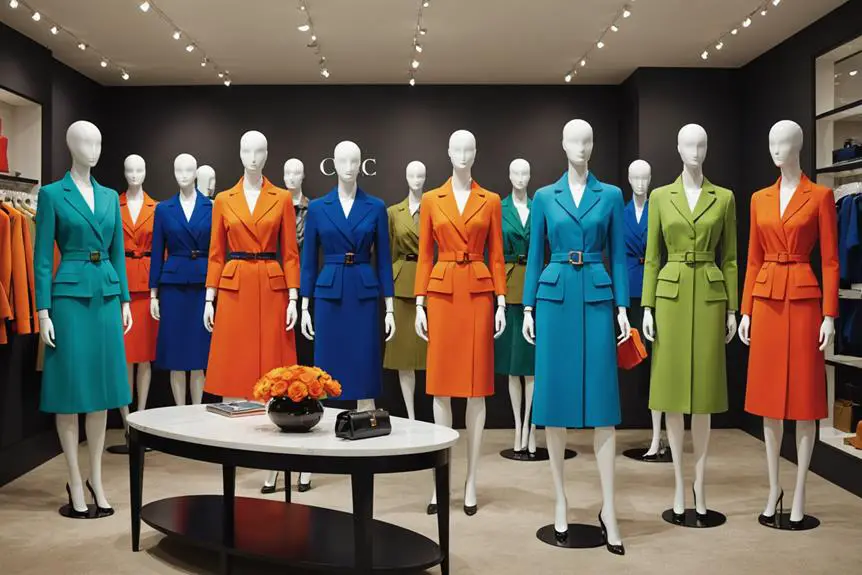A Bathing Ape, commonly known as BAPE, was founded in 1993 by Tomoaki Nagao, also known as Nigo, in Harajuku, Japan. The brand skillfully blended hip-hop culture with streetwear, crafting a distinctive aesthetic that set it apart. Initially, BAPE limited its production to just 50 shirts per week, which significantly enhanced its exclusivity and desirability. The brand's popularity surged in the late '90s and early 2000s, fueled by collaborations with influential figures such as Pharrell Williams and Kanye West. Iconic items like the BAPESTA sneaker played a pivotal role in establishing BAPE's reputation within the fashion industry. As BAPE continues to innovate with a focus on sustainability and global expansion, its evolution remains a captivating aspect of its journey. Would you like to explore specific milestones in BAPE's history?
Origins of BAPE

In 1993, A Bathing Ape (BAPE) emerged from the vibrant streets of Harajuku, Japan, founded by Tomoaki Nagao, better known as Nigo. Nigo aimed to fuse hip-hop culture with Japanese streetwear, creating a unique aesthetic that resonated with youth. The brand's name, inspired by the film "Planet of the Apes," reflects a Japanese idiom about overindulgence, hinting at the excesses of contemporary fashion.
BAPE's origins are intricately linked to the NOWHERE boutique, a collaborative effort between Nigo, Jun Takahashi, and Hiroshi Fujiwara. This boutique became a critical player in shaping the Ura-Harajuku fashion scene, positioning BAPE as a cultural tastemaker. Nigo's strategy of limited production—initially capping output at around 50 shirts weekly—ensured exclusivity. By distributing half of these to influencers, he created a buzz that satisfied only 10% of demand. This scarcity model not only drove hype but also solidified BAPE's identity as a brand synonymous with exclusivity strategies. Through these innovative tactics, BAPE established itself as a leader in streetwear, making a lasting impact on the fashion landscape.
Growth and Popularity
BAPE skyrocketed in popularity during the late 1990s and early 2000s, driven by strategic collaborations with prominent brands and influential artists. The streetwear brand's growth can be attributed to its unique aesthetic and the introduction of the BAPESTA sneaker in 2002. Inspired by the Nike Air Force 1, the BAPESTA became a best-seller, especially after collaborations with Kanye West in 2007, which amplified its presence in pop culture.
As BAPE expanded into the U.S. market around 2005 and 2006, flagship stores opened in New York and Los Angeles, catering to the burgeoning demand from American hip-hop culture. Pharrell Williams played an essential role in this expansion, promoting BAPE among celebrities and influencers, further enhancing its visibility.
Key Collaborations

A series of strategic collaborations has been pivotal in amplifying BAPE's influence within the streetwear and fashion industries. These partnerships have not only enhanced visibility but also solidified BAPE's identity in various cultural arenas.
- In 2003, BAPE's collaboration with Pharrell Williams led to the launch of the Billionaire Boys Club and ICECREAM brands, greatly boosting BAPE's visibility in the U.S. market.
- The 2001 partnership with Pepsi marked a notable shift in BAPE's marketing strategy, expanding its reach beyond Japan.
- BAPE's BAPESTA sneaker, inspired by the Nike Air Force 1, gained popularity through collaborations with Kanye West in 2007, solidifying its status in hip-hop culture.
- Other prominent collaborations include partnerships with major brands such as Adidas and Comme des Garçons, merging streetwear with high fashion.
Through these collaborations, BAPE not only tapped into the essence of pop culture but also established itself as a key player in the evolving landscape of streetwear. The synergy between BAPE and influential figures like Pharrell and Kanye demonstrates how collaborations can redefine brand perceptions and drive commercial success.
Cultural Impact
Streetwear culture owes much of its evolution to the innovative spirit of brands like BAPE, which emerged as a defining force in the late 1990s and early 2000s. BAPE's unique blend of fashion and hip-hop aesthetics established it as a cultural phenomenon with a lasting global influence. Collaborations with iconic musicians like Pharrell Williams and Kanye West greatly enhanced BAPE's visibility, embedding it deeper within urban fashion scenes.
The brand's marketing strategy, characterized by exclusivity, set new standards for streetwear. By limiting product availability, BAPE cultivated a cult following, influencing countless brands to adopt similar tactics. This strategy not only amplified the desirability of their pieces but also solidified BAPE's status as a collector's dream.
BAPE's iconic motifs, such as the Shark hoodie and its signature camouflage patterns, have transcended their origins, becoming symbols of streetwear recognized worldwide. With strong Japanese roots, BAPE exemplifies the fusion of youth culture and consumerism, creating a legacy that continues to resonate in contemporary fashion. Its cultural impact is undeniable, as BAPE not only shaped streetwear but also redefined how fashion interacts with music and lifestyle.
Future Prospects

Without a doubt, the future prospects for BAPE appear promising as it navigates an ever-evolving fashion landscape. To maintain its relevance and guarantee long-term success, BAPE must focus on several key areas:
- International Expansion: Targeting Asian markets will allow BAPE to leverage its strong brand loyalty and cultural significance, reaching more fashion enthusiasts.
- Innovative Collaborations: By partnering with both mainstream and niche brands, BAPE can revitalize its offerings, fascinating new audiences and staying ahead in the competitive fashion industry.
- Sustainability Initiatives: Future product lines are likely to prioritize ethical production practices, aligning with shifting consumer preferences that increasingly demand sustainable fashion.
- Enhanced Digital Marketing: Strengthening its online presence will be vital, particularly in engaging younger generations through tailored digital marketing strategies that resonate with current streetwear dynamics.
As BAPE adapts to these trends, it positions itself not just to survive but to thrive in a competitive landscape. By focusing on these elements, BAPE can guarantee that it remains a relevant and exciting player in the global fashion industry, securing its legacy for years to come.
Frequently Asked Questions
What Is the Story Behind Bathing Ape?
You'll find that Bathing Ape's story revolves around exclusivity and youth culture. By limiting production and collaborating with artists, it created a unique identity, capturing the essence of streetwear and enchanting a global audience.
What Does a Bathing Ape Stand For?
A Bathing Ape stands for a critique of consumerism and overindulgence in youth culture. It blends playful aesthetics with streetwear, promoting exclusivity and desirability through limited production, reflecting a unique intersection of art and commerce in fashion.
Why Is BAPE so Popular?
BAPE's popularity arises from its unique blend of streetwear and luxury, exclusive releases generating hype, collaborations with influential celebrities, and iconic designs that resonate with youth culture, making you crave their products even more.
Who Owns BAPE Now?
BAPE's current ownership lies with Hong Kong's I.T Group, which acquired the brand in 2011. They've focused on expanding its market presence, particularly targeting youth culture in Asia while maintaining the brand's distinctive identity.





Hey! I know this is kinda off topic but I was wondering if you knew where I could find a captcha plugin for my comment form?
I’m using the same blog platform as yours and I’m having problems finding one?
Thanks a lot!
555
555
555
555
BlC5exrX
1*555
(1453-893-5)
1????%2527%2522
Immerse into the breathtaking sandbox of EVE Online. Become a legend today. Trade alongside hundreds of thousands of pilots worldwide. [url=https://www.eveonline.com/signup?invc=46758c20-63e3-4816-aa0e-f91cff26ade4]Begin your journey[/url]
555
555
555
555
555
555
555
555
555
555
555MeperQoB
555*1
555+213-208-5
555*if(now()=sysdate(),sleep(15),0)
5550’XOR(555*if(now()=sysdate(),sleep(15),0))XOR’Z
(select(0)from(select(sleep(15)))v)/*’+(select(0)from(select(sleep(15)))v)+'”+(select(0)from(select(sleep(15)))v)+”*/
555-1); waitfor delay ‘0:0:15’ —
555k1uGs3Se’; waitfor delay ‘0:0:15’ —
555-1) OR 552=(SELECT 552 FROM PG_SLEEP(15))–
5555iPhP1Kl’ OR 161=(SELECT 161 FROM PG_SLEEP(15))–
555*DBMS_PIPE.RECEIVE_MESSAGE(CHR(99)||CHR(99)||CHR(99),15)
555